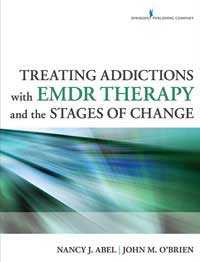 358 pages
358 pages9 CE credits
Course Enrollment
$210.00
Add to Cart
All exams are taken online. The exam for this course will be available in "My Courses" immediately upon enrollment. Note the book is not included.
The book is available for purchase from Amazon.
As an Amazon Associate we receive a rebate from qualifying purchases.
TREATING ADDICTIONS WITH EMDR THERAPY AND THE STAGES OF CHANGE
Nancy Abel, LCSW and John O'Brien, Ph.DSpringer Publishing, 2014
DESCRIPTION
Mental health practitioners must be prepared to treat addiction-related issues affecting up to 50% of mental health clients whether or not clients present with addiction as a primary concern. This practical roadmap to the treatment of addictions advocates an underutilized yet highly effective method of intervention: eye movement desensitization and reprocessing (EMDR) therapy. It is the first book to integrate the Stages of Change Model with EMDR's phases for successful treatment outcome. The book addresses the scope of problems relating to addiction, including relevant statistics and descriptions of substance and process addictions, and considers the connection between addiction and trauma. While focusing on the use of EMDR therapy in treating addictions, the book also considers traditional models for each stage of treatment so interventions can be individualized according to the needs of each client.
The authors describe in detail the Transtheoretical Model, tracing its development and theoretical foundations. They discuss each of its stages in depth, presenting and integrating EMDR interventions used by therapists in each stage. The interventions are useful for helping clients at any motivational level. Case vignettes in each chapter illustrate how EMDR techniques are used, and several detailed cases are provided at the end of the book. The appendix features additional resources and EMDR protocols. The text will be useful for therapists currently using EMDR for addiction treatment as well as those using other modalities who are seeking an effective alternative.
Key Features:
• Provides a practical roadmap to using the Stages of Change Model and EMDR therapy for effectively treating addictions
• Addresses substance and process addictions in depth
• Focuses on the trauma addiction connection and treatment options
• Describes each Stage of Change and EMDR protocols and interventions for each stage
• Includes case vignettes and detailed case examples
The reader will be able to:
• Review basic theories and techniques of EMDR and stages of change
• Describe the 8 phases of EMDR
• Assess indications of your client's addictions and comorbid trauma and design strategies for EMDR therapy toward treating these indications
• Define consecutive-day EMDR
• Examine therapies that can be combined with EMDR to treat difficult cases of trauma and alcoholism
• State the views of the author on the stages of change with marijuana
• Examine the statistics on sex addiction comorbid with substance addiction, and be prepared to assess clients for these indications and to use EMDR therapy in the treatment
• Realize many disorders including substance-abuse disorders and sex addiction are comorbid with PTSD and, therefore, assessment should be set in place on where EMDR can be used for any or all indications
• Create a checklist for the most constructive screening tools and their uses with EMDR therapy
• Compile a list of treatment protocols, including EMDR, for analyzing strategies for therapy
• Create a resource list for group therapies and '12-step' support groups, especially those that recognize the value of EMDR therapy
AUTHOR
Nancy Abel, LCSW, and John O'Brien, PH.D, are both clinicians in private practice in Maine.
ISHK CE at Home
1702-L Meridian Ave., #266
San Jose, CA 95125-5586
This website uses cookies to ensure you get the best experience on our website. Learn more
